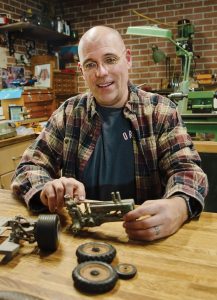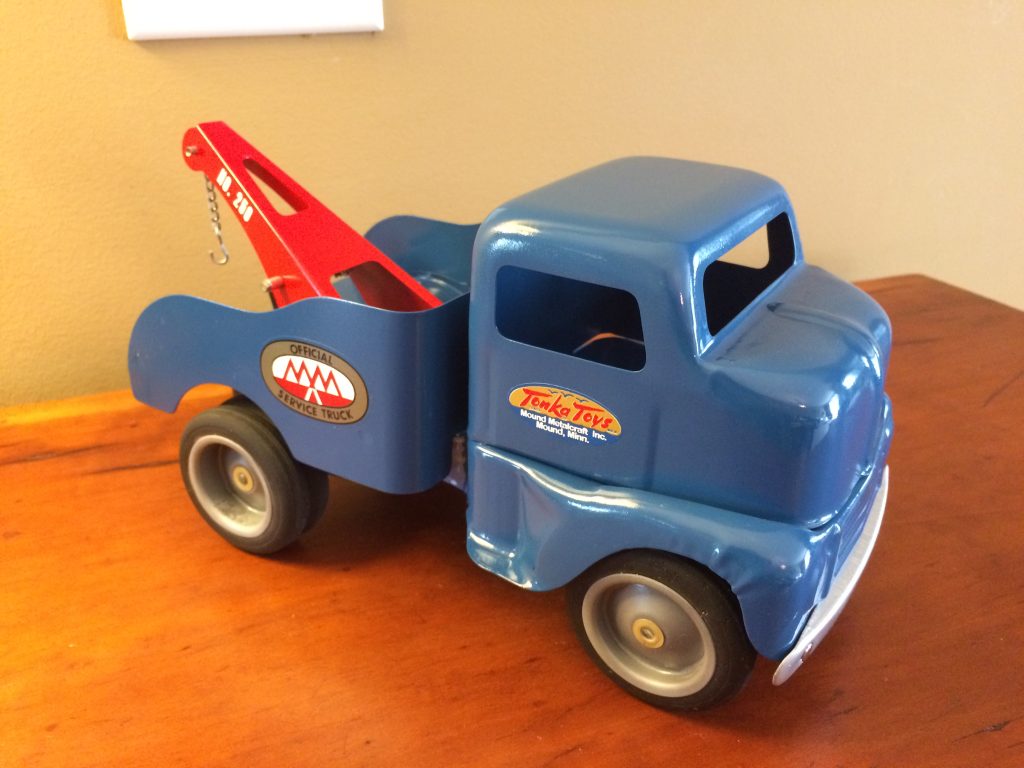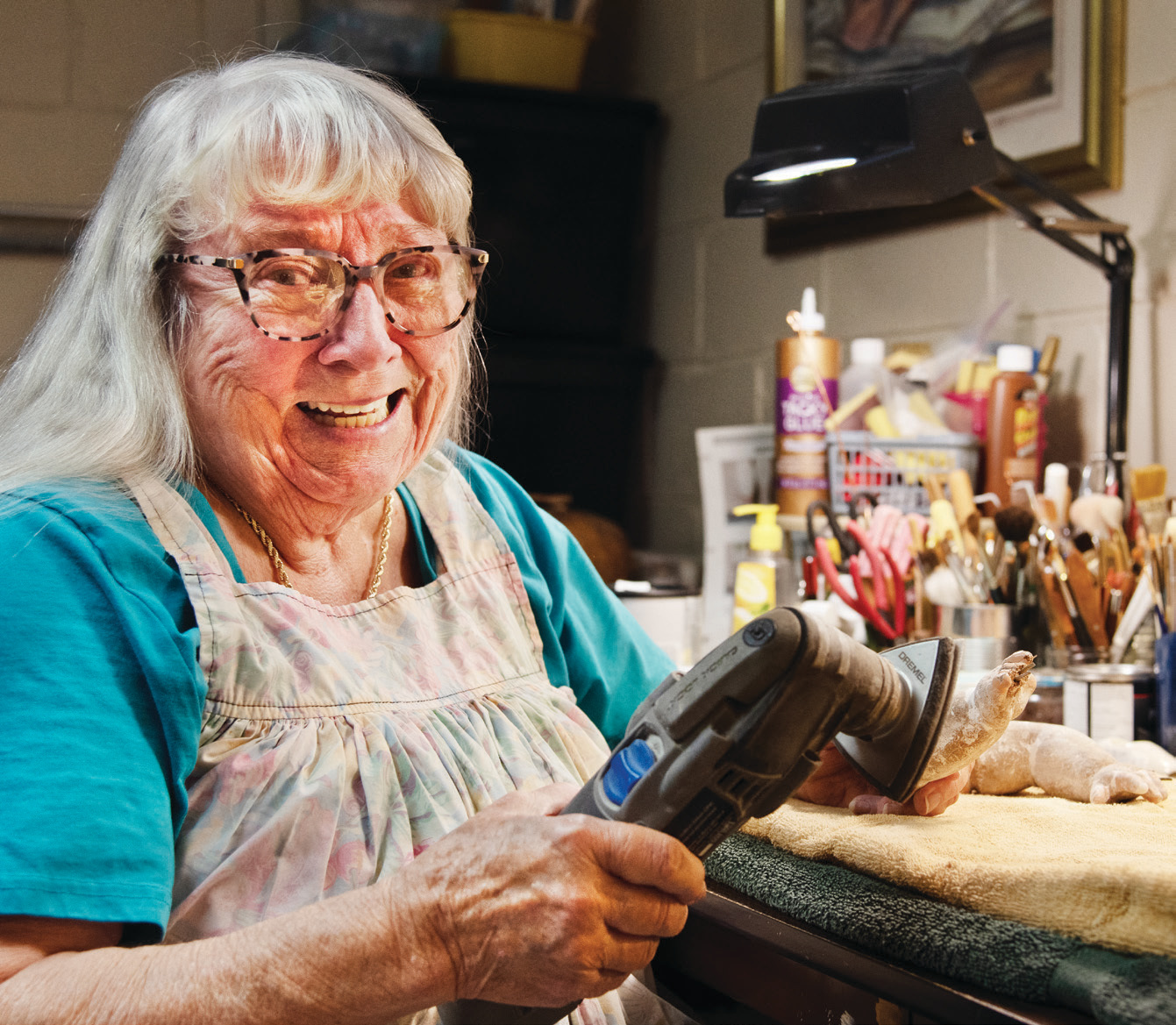
By Richard Biever
The lovely lady from Lafayette brought Lavonne McCarty an old doll with sunken eyes and cracked facial features and limbs. The doll had belonged to and was loved on by her mother-in-law as a little girl. Her mother-in-law had just been moved into a nursing home.
The doll came with a dress, now tattered and stained, that her mother-in-law had made for it some 75 years earlier. The woman asked McCarty, a doll maker and mender, to restore it as best she could, despite the cost of her labor.
“She wanted to get this doll restored for her mother-in-law for Christmas,” said McCarty. “Thinking this was something that somebody played with as a girl is stunning. It wasn’t expensive. It wasn’t good quality. But for girls who played with dolls, it brings back memories that you can’t recreate.”
The elderly caller from California was looking for someone who could repair an old plastic Tiki necklace charm from a box of Cracker Jack. The loop on its tiny head for the string was broken, the caller said. Jason Spangle, whose Old Foundry Toy Works specializes in restoring rare, antique mechanical and metal collectors’ toys, told her that she could probably find the same exact charm on eBay for $8.
“No, I want this one,” she insisted.
She sent it to him, and Spangle worked his magic in his rural Boone County shop that’s filled with specialty high precision, machinist, and metal-working tools. He experimented with some plastics and blended it with the tiny toy to fashion a new loop. He had to charge her $30 or $40 for his effort, he noted. “But she was overjoyed. It looked like it was never broken,” he added.
“Early on, I realized the value of sentimental things,” he said. “Sentimental work is just as important, if not more than my regular repair work I do for institutions, other companies, and other antique toy stores. But no matter if it’s that $8 Cracker Jack charm or a $100,000 Marklin antique battleship, I treat them all exactly the same.”
Christmas memories are eternal. Toys from Santa’s workshop? Not so much.
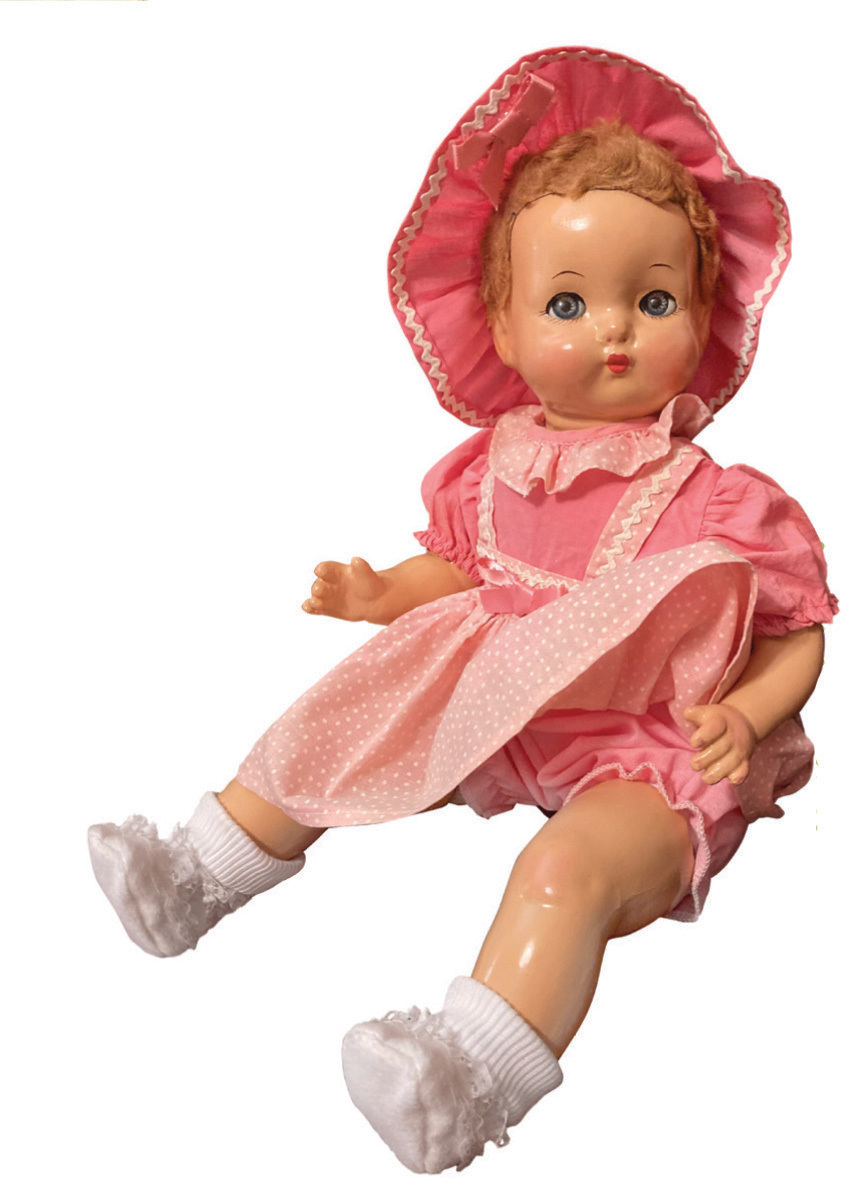
Having elf-made antiques repaired and restored has gotten a lot easier these days thanks to a little cottage industry of Hoosiers. Artisans like McCarty, whose home and workshop is in Beech Grove, and Spangle, on Boone REMC power lines north of Lebanon, take the shattered shells of old porcelain dolls or rusted dinged-up metal fire trucks and make them look and perform as they did long ago — when they first lit up tiny freckled faces and made memories beneath a tinsel-covered Christmas tree.
“There’s a part of me that always wanted to be a doctor to help people,” McCarty said. “Now, I bring back people’s memories.”
“The greatest feeling in the world is when I hear from somebody, and they’re just overjoyed when they receive something I’ve restored,” Spangle noted. “They get their whole family around it, and they get it going if it’s mechanical. It’s super special to them. And to think I was a part of that. I think this is what I was supposed to do in life.”
Though McCarty, 81, and Spangle, 48, operate on different types of antique toys, both admit to getting teary-eyed themselves when they see or hear how much joy their labors of love bring to their clients.
“It’s fun to watch a person sit down and have a memory put in their lap,” McCarty mused.
BLUEPRINTS
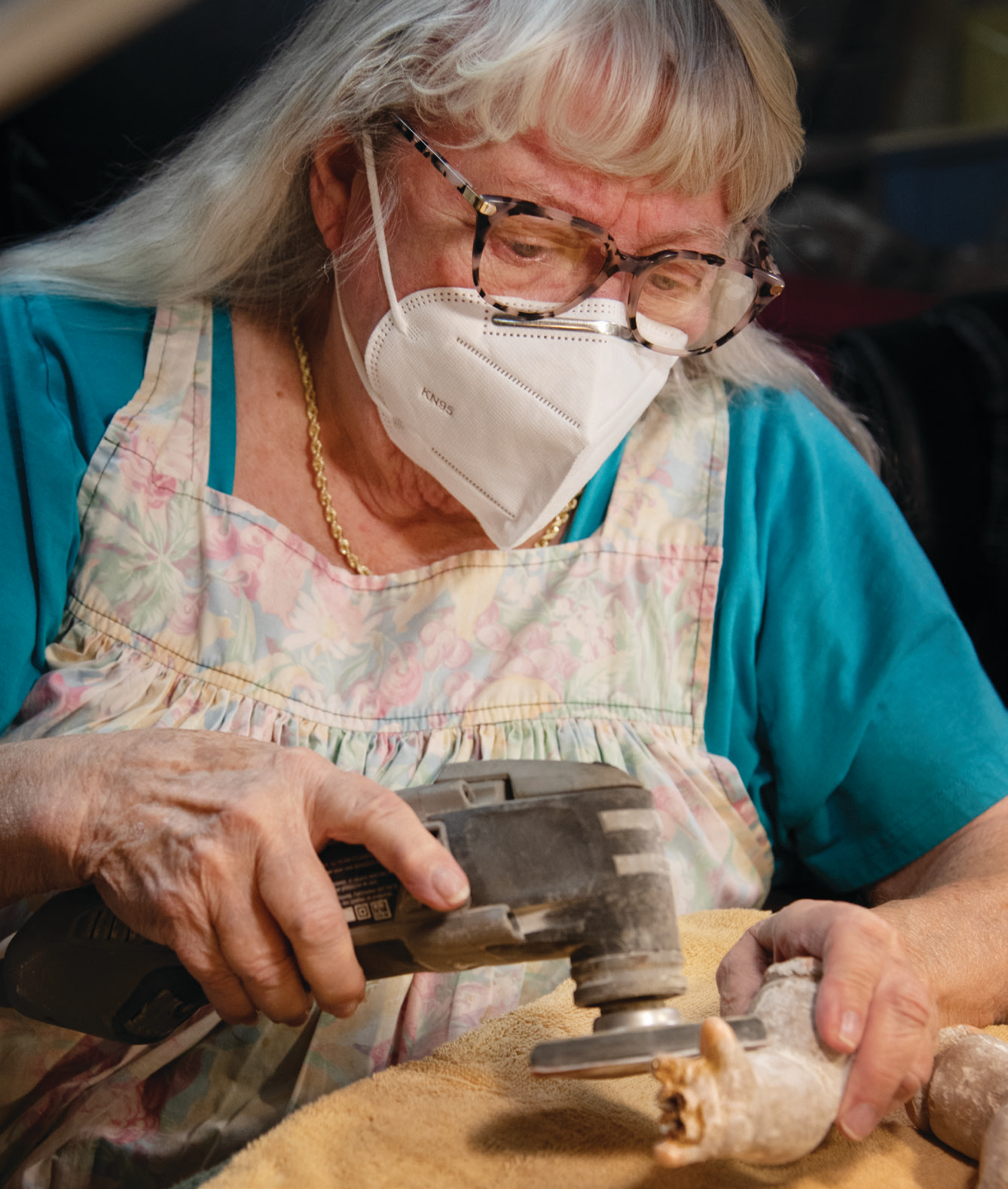
McCarty’s late career venture into doll making and mending followed a circuitous route. But it had its roots in her childhood.
“As a kid, I wanted to be a surgeon. I don’t know why,” she said. “And so I operated on the dolls I had.”
When she was little in the 1940s, most of her dolls had cloth bodies. She’d take her mom’s manicure scissors and … “I did my surgery, and then I’d stitch them up. Needless to say, my mother didn’t keep any of my dolls,” she laughed, noting the condition she left them in.
While she had the grades for medical school, her family didn’t have the funds. She directed her attention toward art. After high school in 1960, she attended the prestigious John Herron Art Institute in Indianapolis (now a school within Indiana University).
After college, she worked as a commercial artist. But she and her first husband divorced, and she had a young son to raise. “I’ve been a fashion illustrator. I’ve been a book illustrator. But you don’t make any money,” she explained. “It was OK if you’re married and you’re a second income. But a woman with a child could not survive on that income.”
So, she took a job at a large commercial printing plant in Indianapolis. McCarty worked in the negative stripping and plate making area, the last steps before printing.
After 17 years there, in 1987, she was caught up in a downsizing. That’s when she began taking classes on doll making which rekindled her artistic spirit.
While still in college at Herron, she also had studied sculpture. An instructor pulled her aside one day and taught her how to pour and fire liquid porcelain. “Lavonne,” the instructor told her, “you’re going to want to know how to do this. You’re going to need to know how to do this.”
At the time, McCarty said it meant little to her. But 30-some years later, that knowledge paid off as she began firing molded porcelain for the dolls she created.
She began creating and selling high-end collector dolls. Not only would she mold and fire the porcelain dolls’ faces and physical features, but she painted the works and designed and sewed their clothing and styled their hair. In 1996, she took a giant leap and purchased Porcelain by Marilyn, a doll store near Greenfield, from the eponymous owner who was retiring.
Unlike McCarty, Spangle’s career in toy restoration began in college. But it’s not what he was studying.
Spangle grew up in Rensselaer. And while colorful molded plastic G.I. Joe and superhero action figures were all the rage in the 1980s, his boyhood interests in toys focused on soldiers and warships from another era.
He recalled on hot summer days, his mom would walk him and his little brother to the library a couple blocks away where they’d check out whatever books they wanted. Then they’d hunker down in the living room that had their home’s only window air conditioner. “And then we would just look at books,” he said.
One of those books was “The Golden Age of Toys,” a large manual detailing metal and intricate mechanical toys of the late 1800s and early half of the 1900s. Most had become collectors’ items, but they captured his fancy. The book included metal soldiers and the aforementioned World War I Marklin toy battleships. “That’s when I really started taking notice of that stuff.”
In high school, his attention turned to computers, and after graduating, he attended Purdue University before transferring to his hometown Saint Joseph’s College, where his mother worked. He then experienced disc problems in his back and had surgery. During his immobile recuperation, he found a whole new world at his fingertips. “While laying down, I started collecting antique toy soldiers on eBay because they were mentioned in that book. And then I started fixing them up.”
He began posting pictures of his restored solders online. The next thing he knew, people were sending him their toys to repair and restore.
In 1999, while still in college, he opened a small toy and restoration shop in the garage next to his mom’s house. His brother, Lance, also has built model race cars and aircraft since childhood and has appeared in several magazines in his own right.
“I’ve always wanted to have a traditional toy shop,” Spangle said. “That probably started when we were doing RC car racing when I was in middle school and early high school.”
He said his first real commissioned miniature work came from Australia. Someone saw his toy soldier restorations and asked if he could make a working model of a Lee-Enfield bolt-action rifle used by Australian soldiers during World War I.
Spangle researched the actual mechanical illustrations of the rifle, and, from scratch, fabricated the gun in 1/6th scale. “I made them a little miniature bolt-action rifle,” Spangle said. “I made patterns, cast them in metal, and then machined them and then sculpted the gunstock, which was actually made out of the same type of wood that the Australian Lee-Enfield would have been made from.”
The only compromise for the work, he admitted, was he couldn’t import the wood — Queensland maple — from Australia and had to settle on getting it from Hawaíi.
Spangle noted he created a simple website that touted the toys and work he could do. “That’s how I started — repairing lead toy soldiers. And then, as the machine shop grew, I started taking on more and more comprehensive work. At this point, there’s pretty much nothing we can’t preserve, repair or restore now.”
While his skills and stature in the unique line of work in which he tinkered and toiled grew — developing clientele from across the U.S. and the world — Spangle felt the original workshop next to his mom’s house lacked a certain gravitas. Like McCarty, he opened a main street store front for his work.
In 2005, at age 30, he took his tools to Lafayette where he opened Old Foundry Toy Works, an antique toy store and restoration shop, in a historic building downtown. “I wanted to feel validity. When it was a home shop, I don’t think it was taken seriously enough.”
BACK TO THE DRAWING BOARDS
McCarty owned the doll store for only five years, 1996–2001. That’s when the public’s interest in doll collecting seemed to nose dive. Despite taking another part-time job at another printing plant, she couldn’t keep the store open.
While owning the store, however, she continued teaching people how to make dolls. People would also come in and asked if she could fix broken dolls. Though it had not been her bailiwick before, “If you learn how to make them,” she said, “you know how to repair them.”
Repairing dolls for people became a new passion, but she soon realized it wasn’t going to keep the shop open, either. She would charge $125 for a thorough restoration, which some folks might quibble about. But if she had 12 to 15 hours in a restoration, something not at all out of line, she’s looking at paying herself $10 an hour. “You make more at McDonald’s,” she said. “But I love doing this. If you love what you do, you never work a day in your life.”
Once she closed the shop, she paid off her debts and bought a small home in Beech Grove, a block from her son and his family.
She recently retired from teaching dollmaking, something she’d done for 28 years. But she stays busy repairing dolls. Most of her work is from return clients or through word of mouth. Most of the antique dolls she works on were from the 1950s or older. She also will repair collector’s dolls with porcelain heads and parts.
Atop her workbench in her basement are jars stuffed with paint brushes of all sizes, and compounds she uses to fill cracks and holes. She uses small sanders to smooth out the glues or compounds before repainting or glazing. Plastic bins, labeled for parts and wigs for various sized dolls, are stacked in corners beside porcelain faces she creates. In another part of the basement, she has three kilns to fire the custom-made porcelain parts.
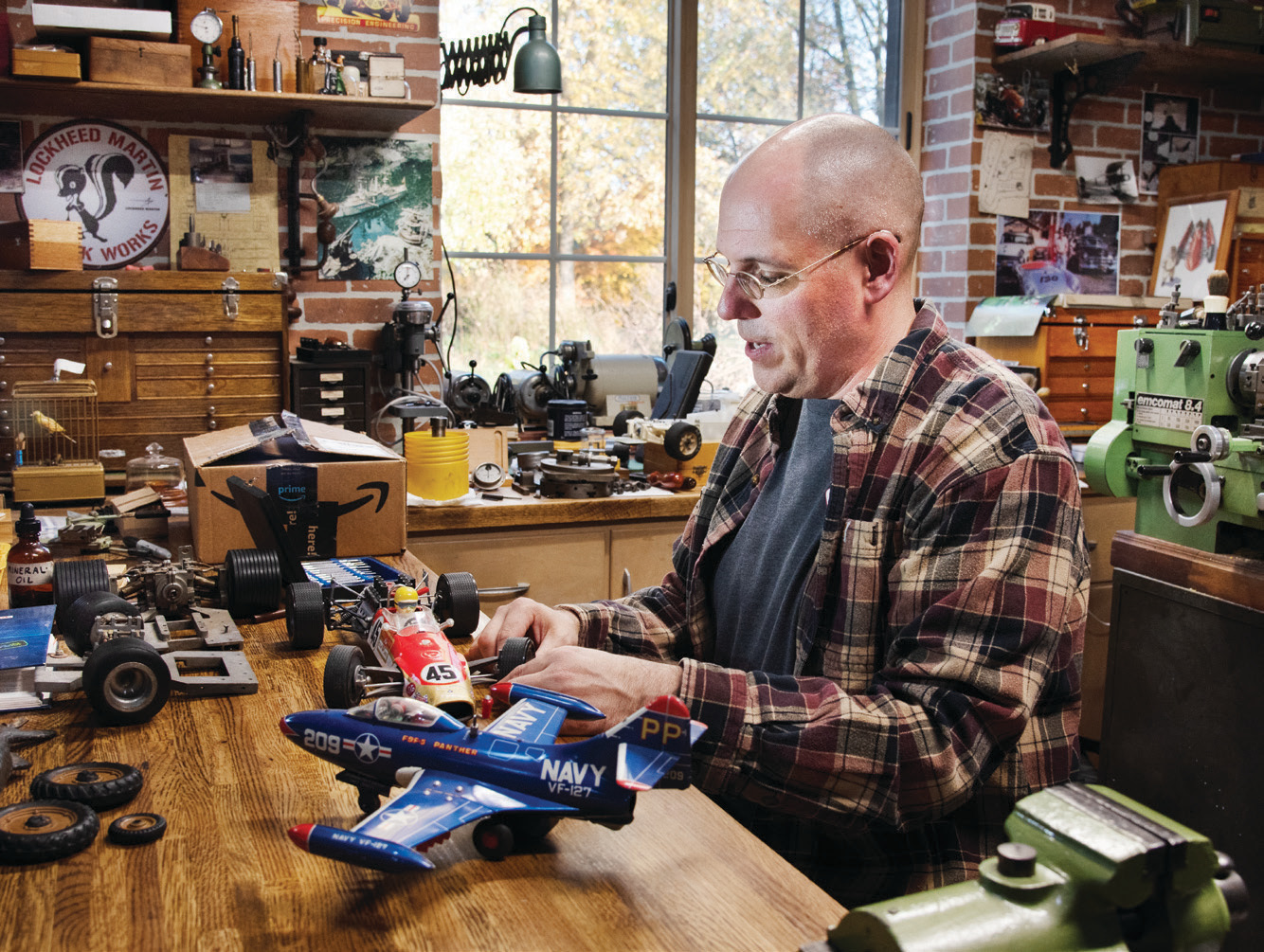
For Spangle, the shop in Lafayette allowed him to expand his workshop. He began accumulating a wide variety of tools and equipment from near and far. He discovered Purdue University’s salvage shop of old lab equipment and tools as a local source for unique precision tools. These shop pieces allowed him to vastly expand the materials he could work on and the detail he could bring in creating replicas of old collector’s toys and restoring the toys of others. He also added a staple of industrial clients — outside the realm of toys and collectibles — for which he did work.
His work has included antique automatons which are mechanical doll-like figures that run with clockwork engineering. Automatons originated in France in the 1800s. He even came to possess original 1920s volumes of books detailing, in French, the mechanisms and diagrams used to create the little marvels.
But the trouble with the storefront was the storefront. “I wasn’t getting anything done,” he laughed. “Kind and curious people came in and were simply amazed at the place. And we would talk for hours.”
He owned the store for just three years, 2005–08.
In 2012, he purchased what is his current location, an old schoolhouse in Elizaville, just northeast of Lebanon. It is undergoing a slow restoration, as well. The school, built in 1909 and expanded in 1958, was shuttered in 1968.
He said soon the building will include provide dedicated areas for his various his complete workshop that will specialties; a library for his more than 9,000 toy and machinist books and catalogs; a traditional 1900s toy shop that will be open to the public; and his family’s living quarters.
Today, the full-service machine shop includes dozens of high-quality American and European machines and custom-made diagnostic equipment. He uses Swiss watchmaking and clockmaking equipment to work on antique mechanical toys or the Victorian automatons. The shop also includes laser cutters, presses, metal forming tools, welders, pattern-making tools, forges and furnaces and casting equipment. He also has 3D printers, mainly used for tooling, that work together with plastic injection molders. He even has what he believes is the world’s largest collection of antique lightbulbs specifically made for toys.
“Proper restorations are some of the most complicated stuff you’ll ever encounter. You’ve got to be a chemist. You’ve got to be an engineer. You’ve got to be an artist. You’ve got to be a painter,” Spangle said. “I’m to the point where I feel I have one of the most technically capable shops in the world, and I’m satisfied with that. It’s my job.”
The little Army doll came to McCarty in pieces. It was a gift her uncle sent to her aunt from overseas during World War II.
At some point, the doll was stowed away in an attic or closet. McCarty said the doll’s body was composed of glue and sawdust. “Mice like glue,” she said. “He ate the insides of it out. The face was left with no nose. And that’s what it looked like,” she noted, pointing to a “before” photo on her phone of a little shattered sharpshooter who’d been left war-torn and tattered.
“That took a while to build his head and everything,” she said. And then she showed the “after:” A sharp handsome young soldier once again standing at attention. (See photos below)
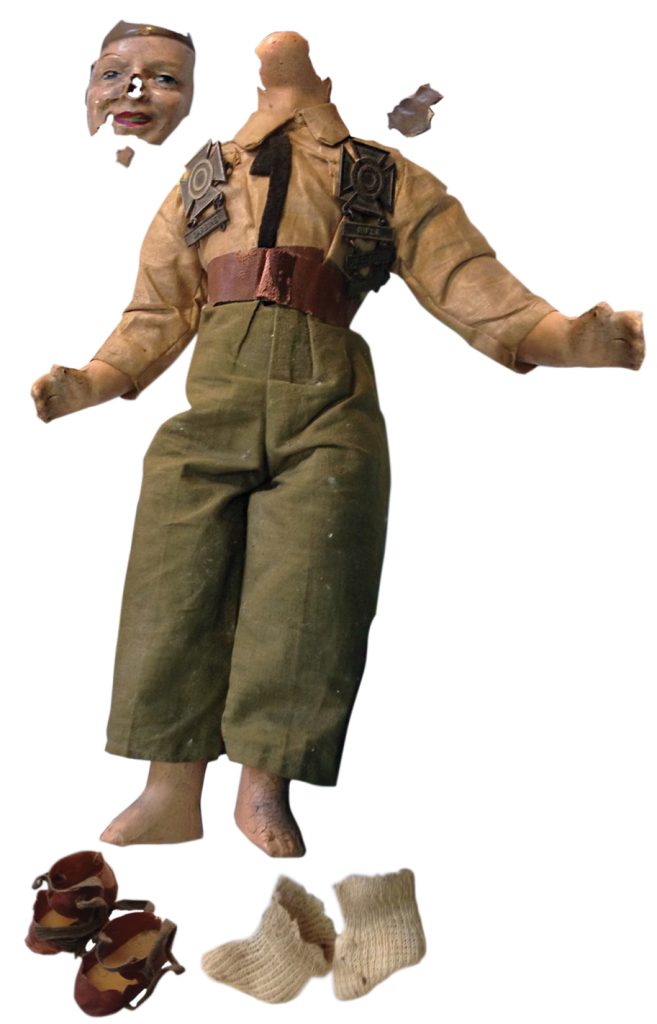
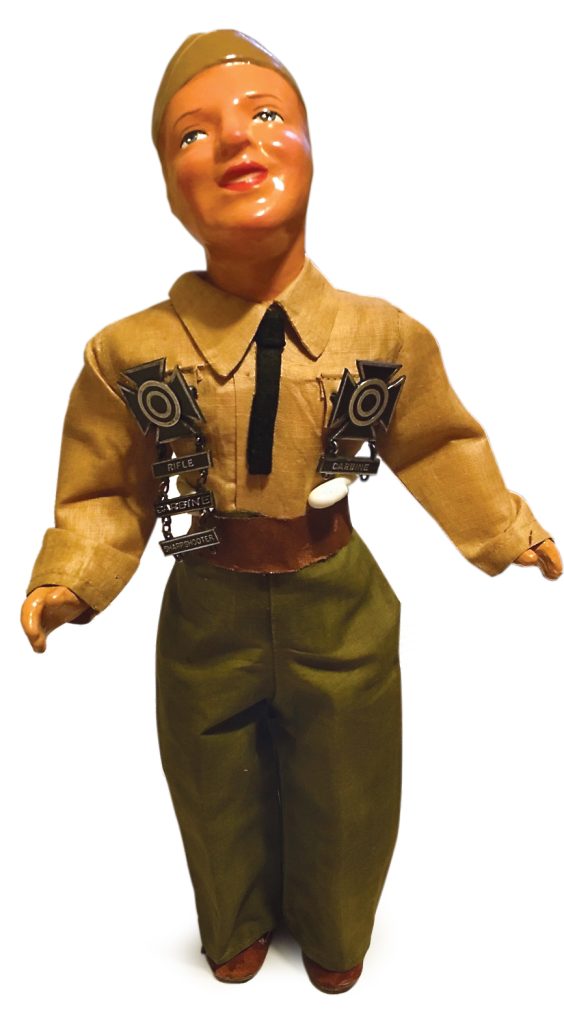
“I do this because the end product is so fun. It makes people so happy,” she added. “Don’t you have childhood memories that you’d like somebody to revive for you? As adults, we have life that we have to deal with. As children, everything was play. You could love a doll; you could bury a Tonka toy.… To bring back somebody’s memories just by restoring their toys? That’s priceless.”
RICHARD BIEVER is senior editor of Indiana Connection
INDIANA TOY AND DOLL REPAIR PROVIDERS
Santa may not have “authorized” repair shops for elf-made toys. But if he did, we’re sure you’d find these Hoosier cottage industries among them for restorations of collector and antiques items like dolls and metal and mechanized toys and games. We always recommend you call or contact the shop or visit them online first.
BIG BOYS TOYS RESTORATIONS
4681 S. 200 E.
Lebanon, IN 46052
317-730-0018
bobpeltz@homespunantiques.com
homespunantiques.com
HOOSIERBOY RESTORATIONS
5858 Churchman Ave.
Indianapolis, IN 46203
317-734-3903
info@hoosierboyrestorations.com
hoosierboyrestorations.com
INDIANA DOLL HOSPITAL
679 W. 375 N.
Greenfield, IN 46140
317-326-2229
carol@dollrepairlady.com
www.dollrepairlady.com
LAVONNE MCCARTY
441 N. 19th Ave.
Beech Grove, IN 46107
317-363-2129
lavonne.mccarty@yahoo.com.
MARQUIS’ DOLLS & RESTORATIONS
214 N. Fifth St.
Lafayette, IN 47901
765-429-6365
On Facebook
OLD FOUNDRY TOY WORKS
6325 N. 500 E
Lebanon, IN 46052
765-742-1020
jason@oldfoundry.com
www.oldfoundry.com
RANDY’S TOY SHOP
165 N. Ninth St.
Noblesville, IN 46060
317-776-2220
randy@randystoyshop.com
randystoyshop.com

